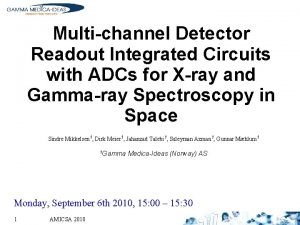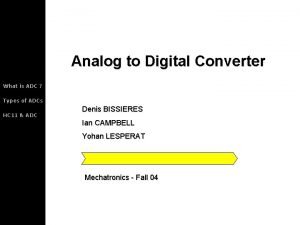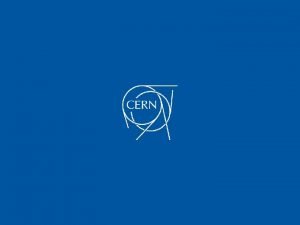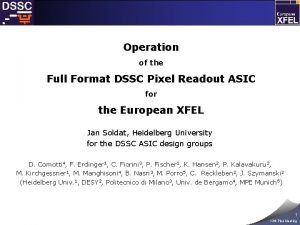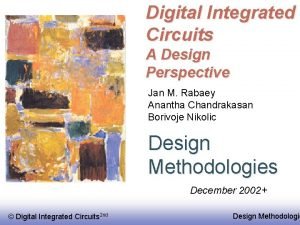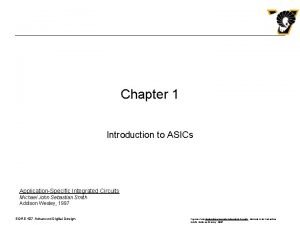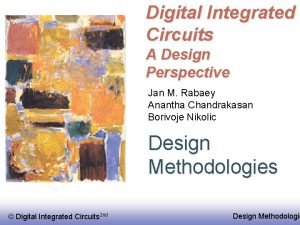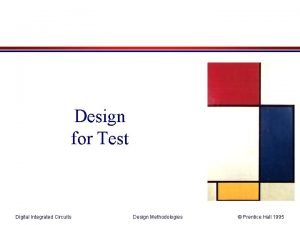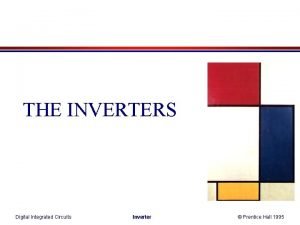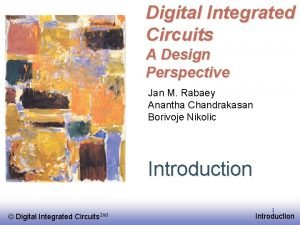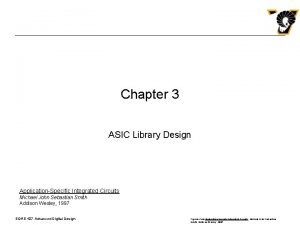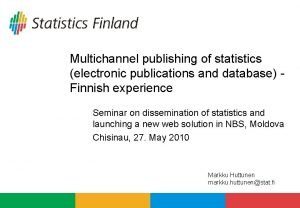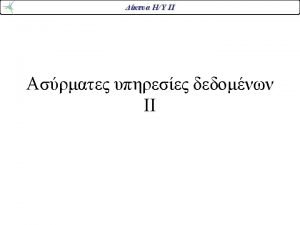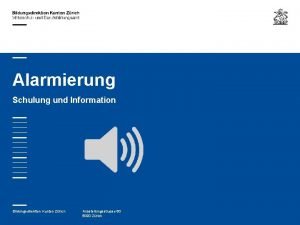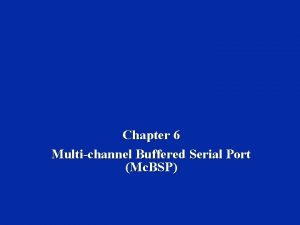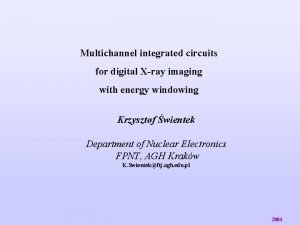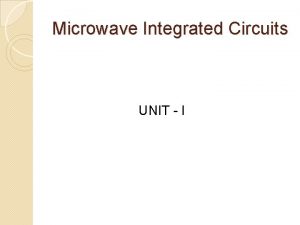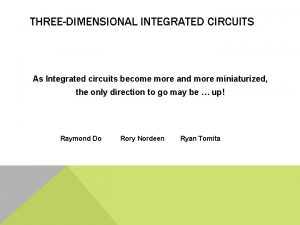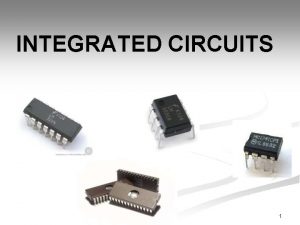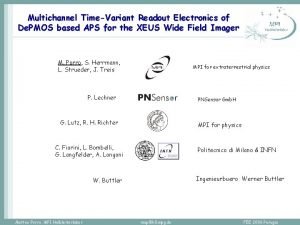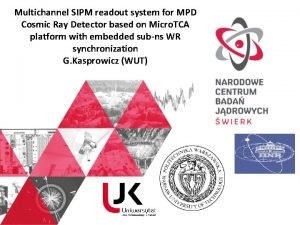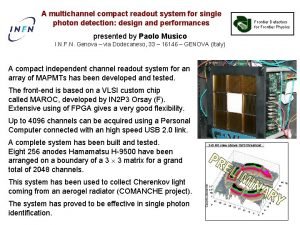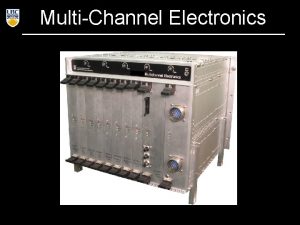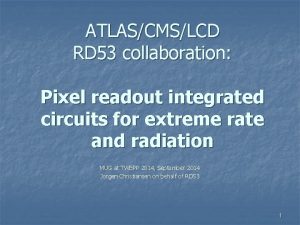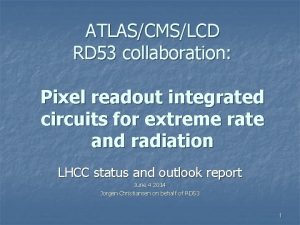Multichannel Detector Readout Integrated Circuits with ADCs for















![ASIC Layout JAXA / KIPAC [Watanabe, vertex 2009] 16 AMICSA 2010 ASIC Layout JAXA / KIPAC [Watanabe, vertex 2009] 16 AMICSA 2010](https://slidetodoc.com/presentation_image/57277c7b80219672eca57ae1a3b08ac7/image-16.jpg)



![Test results (4) VATA 460 (HDR) Energy [ke. V] Measurements performed by Takashima et Test results (4) VATA 460 (HDR) Energy [ke. V] Measurements performed by Takashima et](https://slidetodoc.com/presentation_image/57277c7b80219672eca57ae1a3b08ac7/image-20.jpg)







- Slides: 27

Multi-channel Detector Readout Integrated Circuits with ADCs for X-ray and Gamma-ray Spectroscopy in Space Sindre Mikkelsen 1, Dirk Meier 1, Jahanzad Talebi 1, Suleyman Azman 1, Gunnar Mæhlum 1 1 Gamma Medica-Ideas (Norway) AS Monday, September 6 th 2010, 15: 00 – 15: 30 1 AMICSA 2010

Abstract We are developing detector readout integrated circuits (ROICs) for X-ray and Gamma-ray spectroscopy. The ROICs are applications specific (ASICs) for satellite instrumentation in space. The ICs described in this article belong to the VATA family with integrated analog-to-digital converters (ADCs) for fully digital readout of x-ray and gamma-ray detectors. The VATAs are ideal for the readout of cadmium zinc telluride (CZT), cadmium telluride (Cd. Te), silicon pads and strips, and large area avalanche photodiodes (APDs) with scintillators. The VATAs contain 32 and 64 pre-amplifiers each followed by pulse shaping circuits and level comparators for triggering and address encoding. Each channel contains a Wilkinson ADC that generates a 10 -bit digital word proportional to the amplitude of the input pulse. Upon interaction of radiation in the sensor the VATA delivers digital signals proportional to the energy of the photon as well as a digital address corresponding to the point of interaction. The power dissipation is as low as 0. 2 m. W per channel during normal operation. VATAs are currently under test for the soft gamma-ray detector (SGD) and the hard x-ray imager (HXI) on board of the ASTRO-H satellite mission to launch in 2014 (formerly Ne. XT). Both detectors are Compton cameras based on silicon pads and strips, Cd. Te pixels and pixels, and APDs with BGO scintillators. ASTRO-H will help to study the evolution and structure of the universe. ASICs of the same family are also under test for one instrument in the Mercury Plasma Particle Experiment (MPPE) on board of the Bepi. Colombo mission to Mercury and for the FOXSI rocket experiment. This article describes the VATA architecture and presents results from tests in the lab. 2 AMICSA 2010

Introduction A Family of recently developed Multi-Channel Radiation Detector Readout ASICs. • • Radiation Energy Spectroscopy Radiation Imaging The ASIC family is at the moment being utilized for the following space missions: • • • ASTRO-H (JAXA) Bepi. Colombo MMO (JAXA) FOXSI (NASA/JAXA) Criteria for the ASICs • • • 3 Very low power dissipation Low electronic noise Size and weight – high level of electronic readout integration AMICSA 2010

Space Application (1) ASTRO-H Picture: JAXA GM-I supplies ROICs for 2 instruments: HXI, SGD 4 AMICSA 2010

Space Application (2) Bepi. Colombo MMO Picture: JAXA GM-I supplies ROICs for the MPPE instrument. 5 AMICSA 2010

Astro-H, Bepi. Colombo (HXI, SGD, MPPE) • The Hard X-ray Imager (HXI) – 4 layers of double-sided silicon strip detectors (DSSD) absorbs soft X-rays (<30 ke. V), but transparent for hard X-rays (>30 ke. V) – 1 layer of double-sided Cd. Te detector detects hard X-rays (20 ke. V. . . 80 ke. V) • – BGO well is active shield The Soft Gamma-ray Detector (SGD) is a – non-focusing soft gamma-ray, 10— 600 ke. V • • 6 – narrow-FOV Compton telescope, rejects background radiation GM-I delivers the Read Out Integrated Circuits for the Silicon and Cd. Te detectors Bepi. Colombo MMO MPPE • Single sided strip detector • Measure High Energy Particle energy to investigate the structure and dynamics of the Mercury's magnetosphere. AMICSA 2010 JAXA / KIPAC [Watanabe, vertex 2009]

Design criteria • ASTRO-H SGD (VATA 450), launch 2014: – Very low power – Medium DNR • ASTRO-H HXI (VATA 461), launch 2014 and FOXSI (VATA 451), launch 2011: – Low noise, medium power – Low DNR • Bepi. Colombo MPPE (VATA 460), launch Aug. 2013: – – 7 Low power High DNR Medium noise Large temperature range AMICSA 2010

Radiation Detector Principle 8 AMICSA 2010

VATA-ASIC Basic Functionality 9 Concept Input: Readout of 32/64 radiation sensors/electrodes/strips/pixels 32/64 parallel & independent inputs channels, current input Signal processing • amplitude spectroscopy • simultaneously and independent 32/64 x analog signal processing: • charge sensitive amplifiers CSAs, • Semi-Gaussian shapers, • Discriminators • 10 bit ADC (integrating) • Digital signal processing Data sparsification • Analog amplitude discriminators to identify events • Digital data processing to minimize data output Output: Delivers • Asynchrounous trigger signal • Digitized amplitude and pixel address The trigger is set immediately after first crossing of amplitude threshold. Digital data is read out synchrounously by the system. AMICSA 2010

ASIC TL architecture Four distinct modes of operation: – – 10 AMICSA 2010 Initialization Acquisition (FE) Conversion (ADC) Readout (BE)

ASIC FE Channel Architecture 11 AMICSA 2010

The VATA PRINCIPLE 12 AMICSA 2010

ADC Architecture • 32/64 channels converted in parallel • Integrating single slope ADC (”Wilkinson”) • 10 bit resolution • 10 MHz conversion clock speed • 1 m. W/channel power consumption default, tunable between 0. 5 -2 m. W • 6 bit programmable offset correction • Common mode calculation • Termination of conversion phase when all channels have been converted 13 AMICSA 2010

Back-End Architecture • Digital data reduction • Output data format: – Status bits – Trigger map – ADC data 14 AMICSA 2010

VATA-ASIC Extended Functionality Function 15 Implementation User can adjust • internal bias values • adjust all thresholds individually • enable or disable channels, adjust gain, adjust power/noise, test individual channels progammable configuration register Internal calibration pulse generation Individual channels can be tested through a digital interface Combine several ASICs can be Daisy-chained for serial read-out, control and configuration Compensate change of external temperature Differential signals Compensate large detector leakage current compensation network Electrostatic Discharge (ESD) protection Customized diodes at the inputs, optimized for low noise AMICSA 2010
![ASIC Layout JAXA KIPAC Watanabe vertex 2009 16 AMICSA 2010 ASIC Layout JAXA / KIPAC [Watanabe, vertex 2009] 16 AMICSA 2010](https://slidetodoc.com/presentation_image/57277c7b80219672eca57ae1a3b08ac7/image-16.jpg)
ASIC Layout JAXA / KIPAC [Watanabe, vertex 2009] 16 AMICSA 2010

Test results – Energy Spectroscopy (1) VATA 450 (low power) VATA 450 VA 32 TA 6 JAXA / KIPAC [Watanabe et al. , Vertex 2009] 17 AMICSA 2010 Data taken by JAXA / KIPAC

Test results – Energy Spectroscopy (2) VATA 451 (low noise) Noise (ENC) VATA 450 59 +14 e/p. F VATA 451 27 +6. 6 e/p. F VATA 460 179 +16 e/p. F VATA 461 34 + 5. 5 e/p. F ASIC measurements, by GM-I JAXA / KIPAC [Saito et al. , , SPIE 2010] 18 AMICSA 2010

Test results (3) VATA 460 (HDR) Measurements performed by Takashima et al, JAXA. Energy [ke. V] Threshold of Noise Energy measurement Thresh-hold Temperature[degree] 19 AMICSA 2010 Energy Resolution (FWHM)
![Test results 4 VATA 460 HDR Energy ke V Measurements performed by Takashima et Test results (4) VATA 460 (HDR) Energy [ke. V] Measurements performed by Takashima et](https://slidetodoc.com/presentation_image/57277c7b80219672eca57ae1a3b08ac7/image-20.jpg)
Test results (4) VATA 460 (HDR) Energy [ke. V] Measurements performed by Takashima et al, JAXA. Energy Resolution (FWHM) Under CC-on Energy Resolution (FWHM) under CC-off Noise level under CC-on Temperature[degree]Noise level under CC-off 20 AMICSA 2010

Radiation Tolerance and Latch-up • The most sensitive structures have been tested for radiation tolerance • ASIC fabricated in 0. 35 um CMOS process with epitaxial layer. • ASIC fabrication process has been choosen for good radiation tolerance and latchup immunity. • Initial SEL tests have been performed, and the design has passed these. Reference: H. Aihara, M. Hazumi, H. Ishino, J. Kaneko, Y. Li, D. Marlow, S. Mikkelsen, D. Nguyen, E. Nygaard, H. Tajima, J. Talebi, G. Vamer, H. Yamamoto, and M. Yokoyama, ”Development of Front -end Electronics for Belle SVD Upgrades”, IEEE, Proc. Nucl. Sci. Symp. Conf. Rec. 2000, Vol. 2, 9/213 – 9/216. 21 AMICSA 2010

Radiation test of VATA 460 Gain Noise Radiation test by 6 Me. V/n He. Measurements performed by Takashima et al, JAXA. 22 AMICSA 2010

Legacy of GM-I ASICs in Space Selection of most known missions: • AGILE (launched April 2007). Two different ASICs for the ST instrument and the Super. AGILE instrument: Luigi Pacciani, Ennio Morelli, Alda Rubini, Marcello Mastropietro, Geiland Porrovecchio, Enrico Costa, Ettore Del Monte, Immacolata Donnarumma, Yuri Evangelista, Marco Feroci, Francesco Lazzarotto, Massimo Rapisarda, Paolo Soffitta, “Super. AGILE Onboard Electronics and Ground Test Instruments”, Nucl. Instr. Meth. A 574, 2, 2007, 330 -341. 23 • STEREO/PLASTIC (launched Oct. 2006, http: //stereo. sr. unh. edu/): A. B. Galvin et al. , • SWIFT/Burst Alert Telescope (launched Nov. 2004): L. M. Barbier, F. Birsa, J. Odom, S. D. • AMS (AMS-01 launch 1998, AMS-02 launch 2011): B. Alpat, ”Alpha Magnetic • CREAM (balloon experiment, launch Dec. 2004): M. G. Bagliesi, C. Avanzini, G. Bigongiari, • • • GRIPS (balloon experiment, launch 2012). CALET, (launch 2013). To be installed on the ISS. ASIM (approved for ISS): S. Mikkelsen et al. , ” A Low Power and Low Noise Multi-Channel ASIC for X- “The Plasma and Suprathermal Ion Compositioin (PLASTIC) Investigation on the STEREO Observatories”, Space Science Reviews, 136, 1 -4, April 2008. Barthelmy, N. Gehrels, J. F. Krizmanic, D. Palmer, A. M. Parsons C. M. Stahle, J. Tueller, “XA Readout Chip Characterization and Cd. Zn. Te Spectral Measurements”, IEEE, Trans. Nucl. Sci. 46(1), 7, 1999. Spectrometer (AMS 02) Experiment on the International Space Station ISS”, Nucl. Sci. Tech. 14, 3, 2003. A. Caldarone, R. Cecchi, M. Y. Kim, P. Maestro, P. S. Marrocchesi, F. Morsani, R. Zei, “Front-end electronics with large dynamic range for space-borne cosmic ray experiments”, Nucl. Phys. Proc. Suppl. 172: 156 -158, 2007. Ray and Gamma-Ray Spectroscopy in Space”, Proceedings of AMICSA 2008. AMICSA 2010

Single-event Upset (SEU) • • All configuration registers are implemented with majority vote flip-flops, with 3 storage cells. Automatic error correction Upsets are flagged externally using the trigger line. Occurence of SEU events is flagged in the output data stream. Reference: Samo Korpar, Peter Krizan, Sasa Fratina, ”SEU Studies of the Upgraded Belle Vertex Detector Front-End Electronics”, Nucl. Instr. Meth. , A 511 (2003) 195– 199. 24 AMICSA 2010

Summary • We developed a family of X-ray and Gamma detector Read Out ASICs, suitable for a number of space missions. • Main achievements are. – Reduced power dissipation – Low noise – High level of integration • Other applications include: – Nuclear medicine – Security applications – High energy physic 25 AMICSA 2010

Acknowledgments We would like to thank our colleagues at JAXA and Kavli/Stanford for good collaboration, and for allowing us to use their test results in this presentation. 26 AMICSA 2010

Appendix: Performance Specifications Parameter Number of Input Channels • VATA 450/451 • VATA 460/461 Comment Readout for 32/64 pixels 64 32 Input charge dynamic range • VATA 450 • VATA 451 • VATA 460 • VATA 461 ± 16 ± 1. 6 ± 72 ± 5. 5 TP slow (VATA 450/451//460/461) TP fast 3/ 3/ 2/ 3. 5 0. 6/ 0. 3 / 0. 6 Power consumption • VATA 450 • VATA 451 • VATA 460 • VATA 461 27 Value 0. 25 1. 16 0. 336 1. 28 Charge (f. C), linear range. Some of the ASICs have much higher saturation range at higher non-linearity. µs. Default settings. Power consumption per channel (m. W), nominal bias settings. Acquisition mode. Electronic noise of CSA • VATA 450 • VATA 451 • VATA 460 • VATA 461 59 e + 14 e / p. F 27 e + 6. 6 e / p. F 179 e + 16 e /p. F 34 e + 5. 5 e /p. F Detector Capacitance 5 -7 Optimization value (p. F). Detector Leakage Current 10 p. A Optimization value. VATA 460 has been designed to tolerate up to 36 n. A. AMICSA 2010 Baseline noise and noise slope. At default bias values.
 Readout integrated circuit
Readout integrated circuit What is adc?
What is adc? Readout units
Readout units Readout device
Readout device Full pixel readout
Full pixel readout Series parallel circuit current
Series parallel circuit current Digital integrated circuits
Digital integrated circuits Digital integrated circuits a design perspective
Digital integrated circuits a design perspective Ultra large
Ultra large Application specific integrated circuits
Application specific integrated circuits Digital integrated circuits
Digital integrated circuits Digital integrated circuits a design perspective
Digital integrated circuits a design perspective Integrated circuits
Integrated circuits Power management integrated circuits
Power management integrated circuits Integrated circuits
Integrated circuits Digital integrated circuits a design perspective
Digital integrated circuits a design perspective Characteristics of digital ic
Characteristics of digital ic Asic library
Asic library Multichannel publishing
Multichannel publishing A multichannel retailer sells merchandise
A multichannel retailer sells merchandise Multichannel multipoint distribution service
Multichannel multipoint distribution service Multichannel publishing
Multichannel publishing Multichannel fundraising
Multichannel fundraising Single channel marketing definition
Single channel marketing definition Multichannel-alarmierung
Multichannel-alarmierung Single channel and multichannel data acquisition system
Single channel and multichannel data acquisition system Multichannel buffered serial port
Multichannel buffered serial port Multichannel conflict
Multichannel conflict
